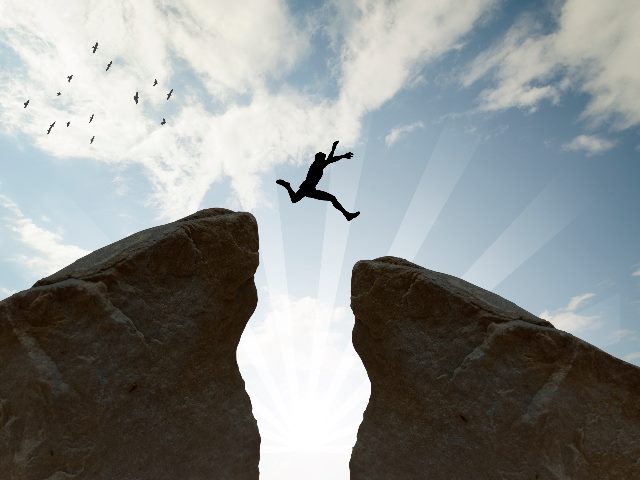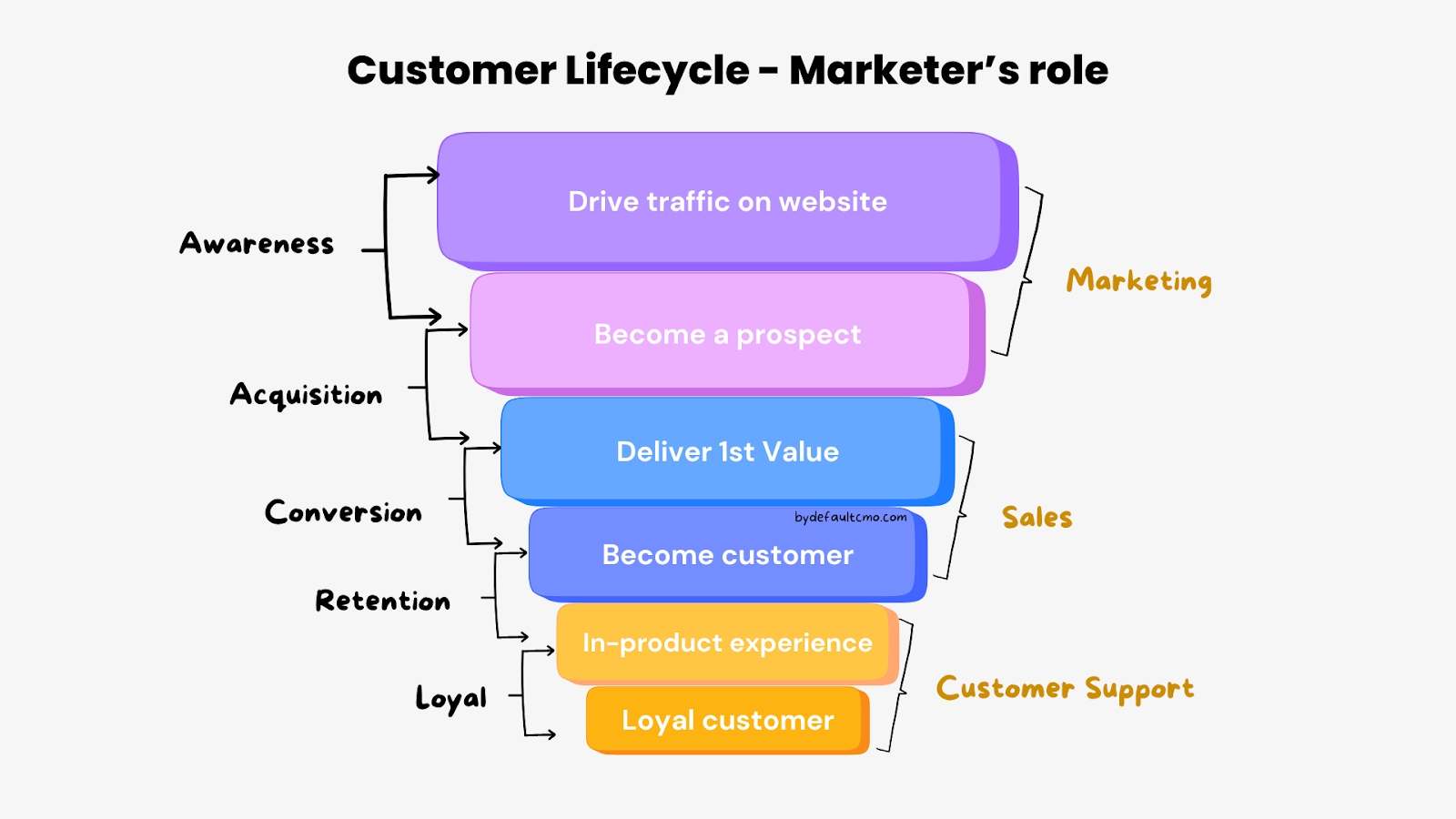
The Gist
- Holistic marketing approach. An effective customer lifecycle requires integrating marketing throughout all stages, improving retention and increasing lifetime value.
- Complex customer journeys. B2B SaaS customer lifecycles are challenging and complex, necessitating tailored strategies to prevent loss and enhance conversion.
- Role clarity is essential. Defining the marketer’s role at each stage of the customer lifecycle ensures consistent engagement and supports customer progression.
It’s commonly believed that a marketer’s job is done once the prospect is handed over to the sales team. However, to enhance customer retention and increase lifetime value, it’s crucial to develop an effective customer lifecycle that incorporates marketing at every stage.
For any B2B Software-as-a-Service (SaaS), the customer lifecycle process is challenging and complex, posing a high risk of losing prospects when transitioning between different stages and teams.
To understand a marketer’s role in the customer lifecycle, we first need to see what it is:
What Is the Customer Lifecycle?
The customer lifecycle helps companies understand how customers experience the product, the actions they take and their progress through the sales funnel. It places the customer at the center of the process, providing insights into their behavior and interactions with your product throughout the buying journey.
When you stop looking at the customer lifecycle from a marketing perspective, it’s easy to forget that customers look at your product differently.
Here’s what a customer lifecycle looks like:

When Do You Need to Focus on the Customer Lifecycle?
It’s important to determine how fast the buying decision is made by the customer and at what price they buy it. If the price of the product is very high, it can’t simply depend on the customer lifecycle and will need a sales funnel to monitor the process.
If you consider how Slack facilitates a smooth transition from its free plan to a paid subscription due to its user-friendly design, the same does not apply to Salesforce. Its free plan shows less efficacy in converting customers to paid subscriptions.
Therefore, it’s important to check what business model your product fits in — bottom-top or top-bottom approach. Based on that you create the strategy that provides the most value to the customers throughout every stage of their relationship with the product.
Related Article: Google Analytics 4 and Making the Most of the Customer Lifecycle
The Stages of the Customer Lifecycle
To successfully make a customer go from being aware of the product to becoming a loyal customer takes a lot of effort and each stage has its goals: awareness, acquisition, conversion, retention and loyalty.
As there are different stages in the customer lifecycle, you would want to start by mapping out the entire customer journey and then set objectives for all stages.

Stage 1: Open Funnel, Wide Scope
The marketing materials you create build awareness, which comes at the top of the funnel and brings visitors to the website, but not all have the probability of becoming a prospect.
At this stage, a large number of people will interact with you; you need to make sure to make good impression, which comes from:
- Building awareness by sharing helpful content — company blog, social media, newsletter, etc.
- Establish authority by creating webinars, e-books on industry-related topics.
It becomes the first goal to bring traffic toward the website mostly through campaigns, marketing materials and building brand awareness.
Stage 2: Become a Prospect
What makes the visitor a prospect is when they show interest by signing up, downloading an e-book, filling out a form, etc. This helps build a contact list and track the conversion rate. It also gives you an idea of whether your content is attracting quality leads that are targeted enough to convert them for the next stage.
It becomes an acquisition stage when you learn about their goals and pain points and explain how their problem will be solved.
When you’re converting a prospect one of the straightforward ways is to build an email marketing or live demo system. Once they leave their email address or go through a live demo, it shows they are interested in the product. This brings us to our main goals here:
- Address their concerns.
- Show them how the product works.
- Overcome any obstacles that may be keeping them from converting.
Stage 3: Deliver 1st Value
There’s usually a reason behind why people download or sign up for the product to experience the value and reach that aha moment immediately.
It becomes a goal to deliver the initial satisfaction as the marketing team has already spent tremendous resources on bringing that prospect.
To reach this conversion stage, your marketing team needs to be well-prepared to communicate those values to the customers.
You’ll need to give your prospect one more push, after raising awareness and nurturing the lead, which can be done by offering a freemium plan or offering a free trial for a few days or by building a personalized onboarding.
As soon as a new customer signs up, collect a few data points, such as:
- Why they are using the product.
- What tasks will be involved in their workflow.
- What problem they are looking to solve.
All these responses will help you segment customers and build a more personalized customer experience.
Stage 4: Become a Customer
It’s so true that the team spends the vast majority of time bringing traffic to the website rather than spending on the customer’s first interaction with the product.
While the first aim is to always build user retention, we also need to focus on account expansion. With the free trial, you give customers the taste of premium features and additional value, which increases the chances of lifetime value and creates a sense of urgency to upgrade the plan.
The first goal after getting a prospect inside the product is to deliver the core value for the first time. They move from being a free user to a paid user. Hence, they become an active user.
Now, they set up the account, connect the account or integrate with other apps. This is the right stage to build retention with a combination of collecting feedback and identifying churns.
Related Article: What Is Customer Lifetime Value and How Is It Calculated?
Stage 5: In-Product Experience
In-product experience isn’t limited to onboarding customers but to constantly track if the customers can work around the product for a month. Track their daily activities and weekly and monthly time spent. Acting upon this data ensures that repeated customers stay subscribed as long as possible.
Your work doesn’t end at customer acquisition because post-purchase nurturing throughout the different stages is crucial to retaining new users long-term which will be done by in-app marketing.
Here’s how you do it:
- Identify the features that you’d like users to discover
- Send in-app messages or notifications; this keeps them in the loop for the latest updates or product improvements.
- Build something like gamification through notification when they successfully complete something to encourage them to take the next steps.
Stage 6: Loyal Customer
This can be a final stage but the customer lifecycle is an ongoing process and moves in a circle.
A customer becomes a loyal customer when they upgrade to additional features, bring teammates, refer to more people and install the habits of using the solution on a regular basis. This transforms into a loyal advocate of your product with high lifetime value and referral potential.
You build a strong relationship with loyal customers:
- By offering them exclusive offers.
- By offering reward programs.
- By listening to them.
- By offering them credits or gift cards.
Developing a Strategy
Now, as shown in the illustration above, moving down the funnel changes the role of who handles what in the team: marketing → sales → customer support.
Developing a strategy can involve marketing efforts, product improvements or customer initiatives. At each stage, you will need to rely on different types of KPIs to evaluate the effectiveness of these strategies, helping you identify areas needing improvement or where to intensify efforts.
Customer Lifecycle: Multistage Journey
As you can see, the customer lifecycle is a long and multistage journey. If managed effectively, you can convert prospects into loyal customers more quickly.
Learn how you can join our contributor community.




